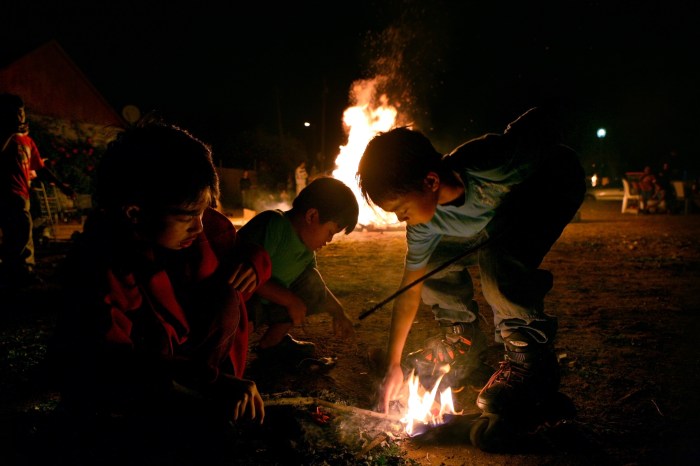
Playing with Fire: A Look at Literal and Figurative Meanings
Playing with fire – a phrase that evokes both literal and metaphorical images. We often associate it with the thrill of danger, the potential for warmth and light, and the ever-present risk of getting burned. But what does it truly mean to “play with fire”?
This phrase has resonated throughout history, shaping our understanding of risk, consequence, and the allure of the unknown.
From the ancient practice of harnessing fire for survival to the modern-day metaphorical use of the phrase, “playing with fire” continues to hold a powerful significance. We’ll delve into the literal act of manipulating flames, explore the various ways the phrase is used metaphorically, and uncover its historical context.
Literal Interpretation: Playing With Fire

Playing with fire refers to the act of manipulating or interacting with fire in a playful or experimental manner. This can range from simple activities like building small campfires to more complex endeavors like fire dancing or pyrotechnics. While fire can be a source of warmth, light, and entertainment, it is crucial to approach it with respect and caution.
Different Ways People Play with Fire
Playing with fire can take various forms, each requiring a different level of skill and safety precautions. Here are a few examples:
- Campfires:Building and maintaining a campfire is a common way to enjoy the outdoors. It involves gathering kindling and fuel, starting the fire, and controlling its size and intensity. Campfires provide warmth, light, and a social gathering point.
- Fire Dancing:Fire dancing is a performance art that involves manipulating flames using various tools and techniques. It requires significant skill and practice to safely handle fire and create visually stunning effects.
- Pyrotechnics:Pyrotechnics encompasses the use of fireworks, flares, and other devices that produce fire and explosions. This field requires specialized knowledge and expertise, as it involves dealing with potentially dangerous materials.
- Fire Spinning:Fire spinning involves spinning objects, such as poi or staff, that are ignited with fire. It requires coordination, dexterity, and careful attention to safety to avoid burns and accidents.
Safety Precautions
Playing with fire is inherently risky, and it is crucial to prioritize safety at all times.
- Clear the surrounding area:Ensure there is a safe distance between the fire and any flammable materials, such as dry grass, trees, or structures.
- Have a water source nearby:Keep a bucket of water or a hose readily available to extinguish the fire quickly in case of an emergency.
- Never leave a fire unattended:Always have someone responsible for monitoring the fire and ensuring it is properly controlled.
- Use appropriate tools:Employ tools designed for handling fire, such as fire starters, tongs, and pokers, to avoid burns and accidents.
- Wear appropriate clothing:Avoid wearing loose clothing that could easily catch fire, and choose materials that are fire-resistant.
Risks and Consequences, Playing with fire
Playing with fire can lead to serious consequences if safety measures are not followed. Some of the potential risks include:
- Burns:Direct contact with fire can cause severe burns, which can be painful and require medical attention.
- Smoke inhalation:Smoke can irritate the lungs and cause respiratory problems, especially in individuals with pre-existing conditions.
- Fire spread:If a fire is not properly contained, it can spread rapidly, potentially causing significant damage to property and even endangering lives.
- Explosions:Certain materials, such as flammable liquids or fireworks, can explode when ignited, resulting in serious injuries or even death.
Historical Context

Fire has been an integral part of human civilization since the dawn of time, profoundly shaping our evolution and development. From its initial discovery to its mastery and utilization, fire has played a pivotal role in shaping human society, influencing our cultural practices, technological advancements, and even our very existence.
The Discovery and Early Uses of Fire
The discovery of fire, although shrouded in the mists of prehistory, is considered a pivotal moment in human evolution. Early hominids, likely utilizing natural fires ignited by lightning strikes, gradually learned to control and reproduce fire. This newfound ability transformed human life in numerous ways.
Fire provided warmth, protection from predators, and a means to cook food, leading to improved nutrition and increased energy for survival.
- Early Evidence:Archaeological evidence suggests that hominids were using fire as early as 1.5 million years ago, with the earliest controlled fire sites dating back to about 400,000 years ago. These sites provide valuable insights into the early uses of fire, such as cooking, warmth, and light.
- Cooking and Nutrition:Cooking food with fire significantly improved human nutrition. It allowed for the consumption of a wider range of foods, including tougher meats and roots, providing more energy and nutrients. This dietary shift contributed to the development of larger brains and more complex social structures.
- Social Bonding and Communication:Gatherings around a fire provided a focal point for social interaction and communication. Firelight extended the day, allowing for storytelling, music, and other forms of entertainment, fostering a sense of community and shared experiences.
Fire in Ancient Civilizations
As civilizations developed, fire became increasingly essential for various aspects of life. Its uses extended beyond basic survival to include agriculture, metallurgy, pottery, and even religious rituals.
- Agriculture:Fire was crucial for clearing land for agriculture, promoting the growth of certain crops, and protecting against pests. The controlled use of fire in agriculture allowed for increased food production, leading to the development of settled societies and the rise of civilizations.
- Metallurgy:The discovery of smelting metals using fire revolutionized human technology. Fire allowed for the extraction of metals from ores, leading to the production of tools, weapons, and other essential items. This technological advancement played a significant role in the development of early civilizations.
- Pottery and Ceramics:Fire was essential for the creation of pottery and ceramics, which played a vital role in storing food, water, and other essential items. The development of pottery and ceramics led to improvements in sanitation, food preservation, and cultural expression.
- Religious and Cultural Significance:Fire was often imbued with religious and cultural significance in ancient societies. It was seen as a symbol of life, power, and purification, and was frequently incorporated into rituals and ceremonies. For example, the ancient Greeks worshipped Hestia, the goddess of hearth and home, who represented the importance of fire in family life.
Fire in Modern Times
Today, fire continues to be a vital force in our lives, powering our homes, industries, and transportation systems. Its role has evolved from basic survival to driving technological innovation and shaping our modern world.
- Energy Production:Fire remains a primary source of energy for power generation. Fossil fuels, such as coal, oil, and natural gas, are burned to produce electricity, providing power for our homes, businesses, and infrastructure.
- Industrial Processes:Fire is essential for various industrial processes, including manufacturing, metalworking, and chemical production. Its heat and energy are used to transform raw materials into finished products.
- Transportation:Fire powers our internal combustion engines, enabling vehicles to move and transport goods. The combustion of fuel in engines provides the necessary energy for transportation.
Playing with fire can be dangerous, but it can also be incredibly rewarding. Sometimes, the best way to show appreciation for the people who light our way is to give them a little something special. Whether it’s a teacher who inspires us, a mom who nurtures us, or a mentor who guides us, finding the perfect gift can be a challenge.
Luckily, there are tons of resources out there to help, like this awesome list of gifts for teachers, moms, and mentors. Just like playing with fire, choosing the right gift can be a delicate balance of thoughtfulness and care.
Playing with fire can be dangerous, but it can also be incredibly rewarding. Learning to control the flames, whether it’s in a campfire or a forge, takes practice and patience. And sometimes, when you’re not quite sure what you’re doing, it’s best to turn to a safer, more whimsical project, like how to make a ribbon balloon.
The colorful ribbons can be just as captivating as the dancing flames, and you’re guaranteed to have a fun, safe time creating something beautiful.
Playing with fire is a metaphor for taking risks, and sometimes, those risks lead to beautiful outcomes. Just like how a simple flame can be transformed into intricate patterns with a little skill, your nails can become canvases for stunning designs.
Check out 5 incredibly cute nail polish tutorials for inspiration. These tutorials will help you master the art of nail art, and who knows, maybe you’ll discover a hidden talent for playing with fire on your fingertips.



